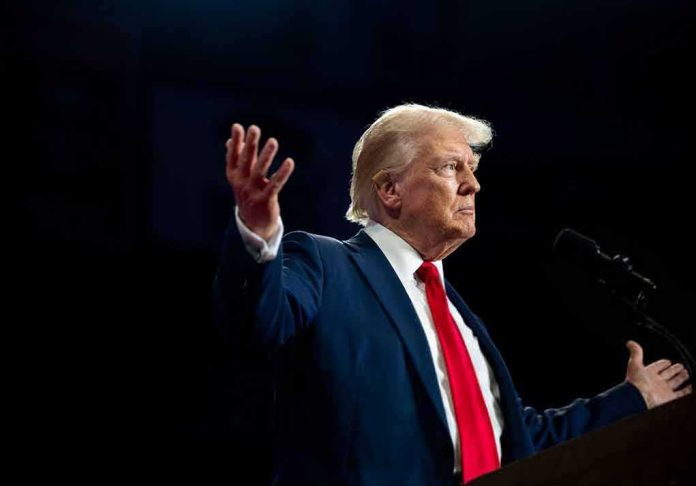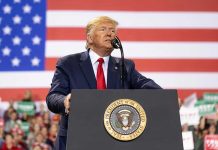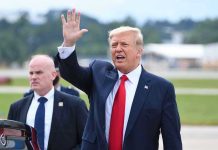
Tariff revenues have surged to historic highs under President Trump’s leadership, delivering billions into U.S. coffers while igniting fierce debate over who really pays the price.
Story Snapshot
- U.S. tariff revenue reached $214.9 billion by September 2025—a record-breaking windfall for federal income.
- Trump’s trade strategy aims to protect American industries, but critics warn of higher costs for businesses and families.
- Ongoing legal challenges, including a pending Supreme Court review, could impact the future of these tariffs.
- Supporters tout tariffs as a victory for American workers and fiscal responsibility, while opponents highlight inflation concerns.
Trump’s Tariff Windfall: Billions Flow into U.S. Coffers
As of September 2025, tariff collections under the Trump administration have soared to an unprecedented $214.9 billion for the year, with $31.3 billion flowing in during September alone. These figures underscore the pivotal role tariffs now play in the federal budget. Trump’s tariffs, originally imposed to counter unfair trade practices and revitalize domestic manufacturing, have become a cornerstone of his economic agenda—delivering a revenue stream that stands in sharp contrast to years of ballooning deficits and unchecked spending.
Trump’s tariff policy began in 2018 with levies on steel and aluminum and quickly expanded to a broader range of imports, especially from China. By targeting goods often linked to globalist trade deals that many conservatives viewed as hollowing out American industry, the Trump administration sought to shift the balance of trade back in America’s favor. Despite fierce opposition from multinational corporations and globalist policymakers, these tariffs have delivered consistent, rising revenue—and have become a major talking point for those seeking fiscal discipline and economic sovereignty.
Controversy and Legal Challenges Surrounding the Tariffs
While supporters of the Trump administration’s approach point to the billions in new revenue and the protection of U.S. jobs, critics continue to argue that tariffs increase costs for businesses and consumers. Some business groups claim the tariffs have raised prices on imported goods, fueling inflation and squeezing family budgets. The legal landscape also remains unsettled: a major Supreme Court case scheduled for November 2025 will determine whether the executive branch acted within its constitutional authority in imposing these tariffs. The stakes are high, as a ruling against the administration could unravel the entire tariff framework and alter the trajectory of American trade policy.
Trump’s defenders counter that the tariffs are not only constitutional but necessary to restore American manufacturing, reduce dependency on hostile foreign powers, and generate revenue without raising taxes on hardworking citizens. They also note that previous administrations failed to secure fair trade deals or protect U.S. workers, allowing American jobs to be shipped overseas while foreign nations manipulated markets and currency. This legal showdown signals a larger ideological clash over the future of American sovereignty and economic self-determination.
Economic and Political Impacts for American Families and Industry
The direct impact of Trump’s tariffs is visible in both the federal treasury and the broader economy. Supporters highlight that increased tariff revenue reduces reliance on deficit spending and foreign debt, giving the U.S. government new leverage in trade negotiations. For American manufacturers, tariffs can level the playing field, encouraging investment and job creation at home. However, opponents warn that cost increases could be passed on to consumers, potentially worsening inflation and straining household budgets. The political implications are just as profound: tariffs have become a rallying point for those demanding an end to globalist policies that put America last.
Short-term data show a clear surge in revenue, but long-term effects—such as changes in global supply chains and the risk of retaliatory measures from trade partners—are still being evaluated. The administration’s willingness to endure criticism and legal hurdles signals a commitment to bold action on behalf of American workers and industries. The outcome of ongoing legal and economic debates will determine whether tariffs remain a pillar of conservative economic policy or face rollback from future political shifts.
Expert Perspectives and the Path Forward
Industry experts are divided, with many economists acknowledging both the revenue gains and the risk of higher consumer prices. Legal scholars closely watch the Supreme Court challenge, which could set a precedent for presidential authority over trade. Supporters of the tariffs see them as crucial to safeguarding the U.S. economy from foreign manipulation and restoring national pride, while critics continue to warn of unintended consequences. What is clear: Trump’s tariff strategy has fundamentally altered the conversation about American economic policy, putting sovereignty and self-reliance back at the center of the national debate.
Sources:
Fox Business: Back-to-back highs—August, September bring $62.6B tariff revenue
PIIE: Trump’s Tariff Revenue Tracker: How Much Is the US Collecting and Which Imports Are Hit?
Bipartisan Policy Center: Tariff Tracker







